-
Do you need help identifying a 🌶️?
Is your plant suffering from an unknown issue? 🤧
Then ask in Identification and Diagnosis. -
✅ Expert and friendly hot pepper grow advice.
✅ The latest information on hot pepper varieties.
✅ Reliable seed trading.
✅ Hot sauce recipes and food safety guidance.
✅ Hot sauce business tips for startups.
🌶️ And more!
It's all here, at The Hot Pepper! The Internet's original hot pepper community! Est. 2004.
You are using an out of date browser. It may not display this or other websites correctly.
You should upgrade or use an alternative browser.
You should upgrade or use an alternative browser.
plant-care Irrigation interval - 24 or 48?
- Thread starter JohnT
- Start date
JohnT said:I am just trying to tell you why everybody does it, politely. Over and out.
That's a bold claim, speaking for everybody. From my experience, most people do it because they think it aids in drainage. But this has been debunked. Like with real science and stuff.
Just to be clear... If you want to continue to put rocks in the bottom of pots, because you believe that it does what you say you think it does, I'm not going to come to your house, and try to enforce my point of view. Honest. You are safe from me. Just know that I will be prepared to discuss this point, whenever it comes up. New growers shouldn't be burdened with old wives tales. That's my respectful opinion on the matter.
I'm only here to help people grow good plants, with the minimum of effort and BS.
I'm only here to help people grow good plants, with the minimum of effort and BS.
solid7 said:Nope, that's not me. I don't belong to that forum, and I don't recall having ever seen that before - so I can't take credit. But it *is* a good share, and helps to try to explain what I was just talking about. ^^^
Thanks.
learned of PWT from you, see below for links to this forum, and used above link as I thought it illustrative of this issue that was never explained here.
http://thehotpepper.com/topic/64081-whats-wrong-with-this-chili-plant/?p=1439741
http://thehotpepper.com/topic/64096-brand-new-pods-dropping/?p=1440140
http://thehotpepper.com/topic/68565-growing-lemon-chili-please-help/?p=1558007
JohnT said:At this point I do not give a rats ass what your opinion is solid7, not because of content (however it is an issue in this case), but rather the way you present yourself and react.
I kindly ask you to not participate in any more of my threads.
I'm sorry, that's not how internet forums work. You put an idea out, you get feedback. You started your thread welcoming opinions. Now you say you don't want certain ones. Nope.
At no point did I make anything personal with you. If I've offended you, without making any effort to do so, the issue is yours, not mine. That was a very oversensitive reaction on your part. You don't like my personality. OK. Whatever. Take it to HR.
The_NorthEast_ChileMan said:
learned of PWT from you, see below for links to this forum, and used above link as I thought it illustrative of this issue that was never explained here.
http://thehotpepper.com/topic/64081-whats-wrong-with-this-chili-plant/?p=1439741
http://thehotpepper.com/topic/64096-brand-new-pods-dropping/?p=1440140
http://thehotpepper.com/topic/68565-growing-lemon-chili-please-help/?p=1558007
Sorry, I misunderstood. I see what you mean. Regardless, it's a good link. I'm not always the best at explaining things, but your link was so simple, even a caveman can do it.
JohnT said:In regards to perched water table. I do fill the bottom of my containers with coarser material although I accept that is no guarantee. My dad taught me that we once got these epic tree containers from a landscaper and he had me pay money to buy bark mulch to put in the bottom, to facilitate drainage.
acs1 said:Got to disagree with you. 'Stuff' added to the bottom of containers isn't to effect the PWT for me. Its to keep the drain holes from getting clogged with compacted soil or 'chunks' of mix. A soft water absorbing piece of wood/compost/peat/bark that fit perfectly on top of the drain holes effectively blocking/sealing them with soft conforming surfaces, no good. IMO anything one can do to facilitate fast complete drainage in containers is a good thing...
I use yard fabric to prevent my media (A mix of Miracle-gro potting media, peat moss, compost and perlite), from compacting over the small layer of pea stones at the bottom of my 5 gallon pails for a different reason - watering. (See below pix for this seperation method.) Let me explain this watering method.... Unlke a tropical environment with the threat of frequent downpours, in New England we can experience very dry periods that require frequent watering. I hand "weigh" my pails and wait until they are much lighter than saturated after my watering method. As I use liquid nutes mixed in the water I place pail in receptacle to catch inevitable run-off from the dry media and the open area around the stones allows the nute-water mix to be wicked up by contact rather than wasted as runoff.JohnT said:
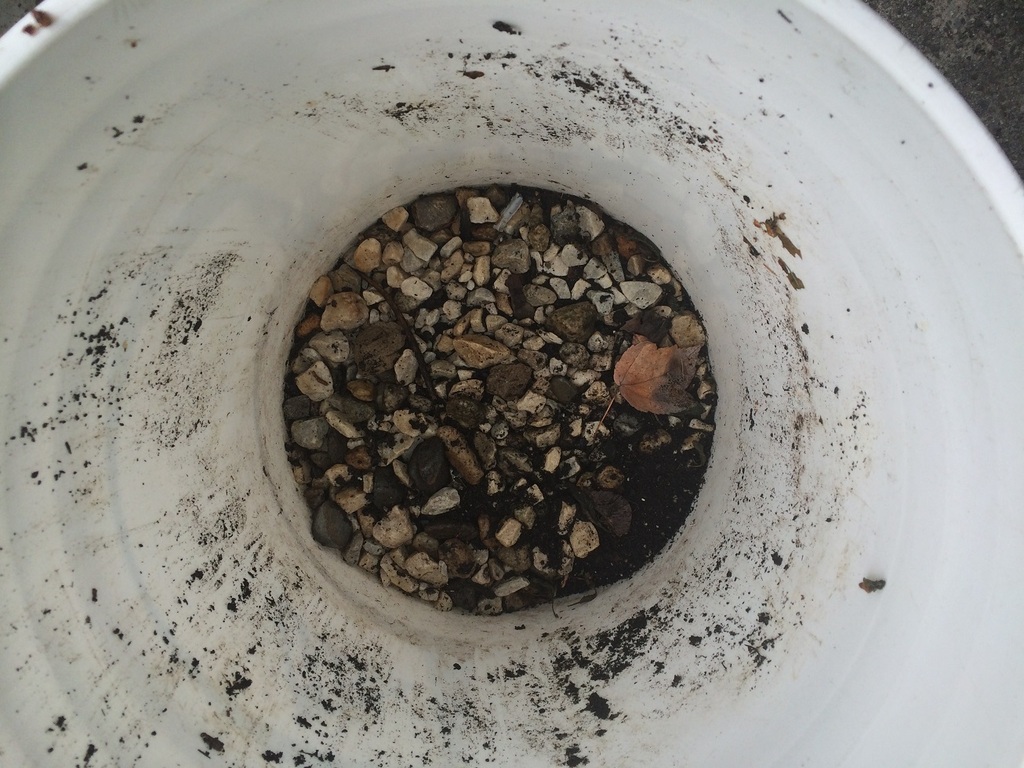
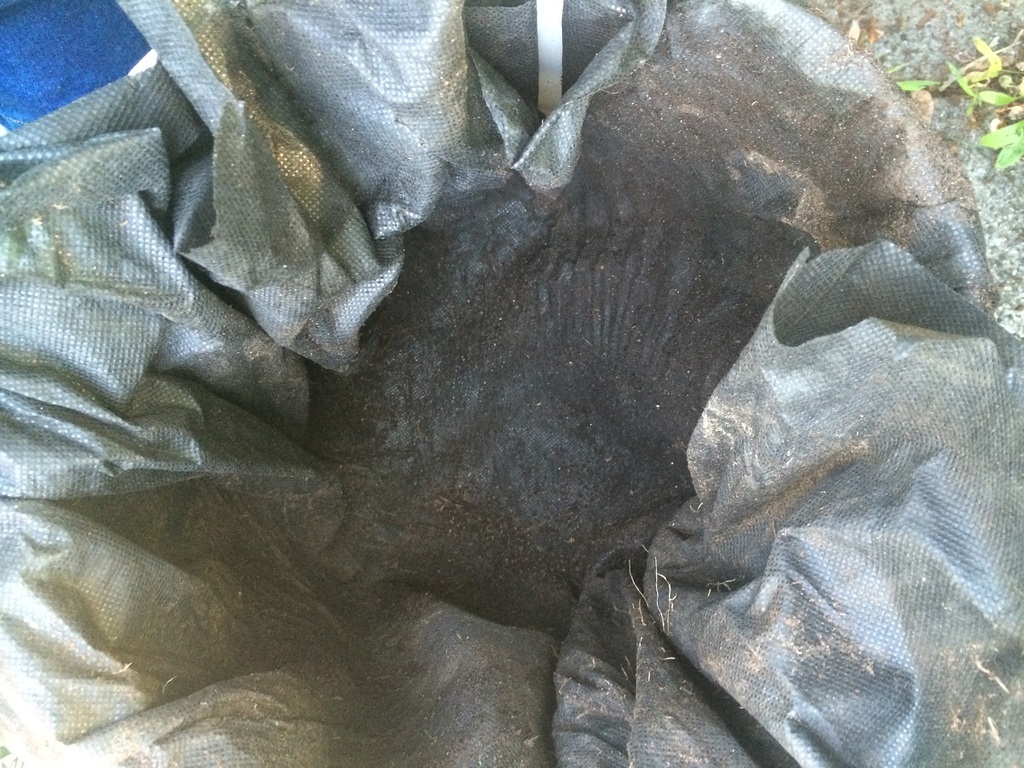
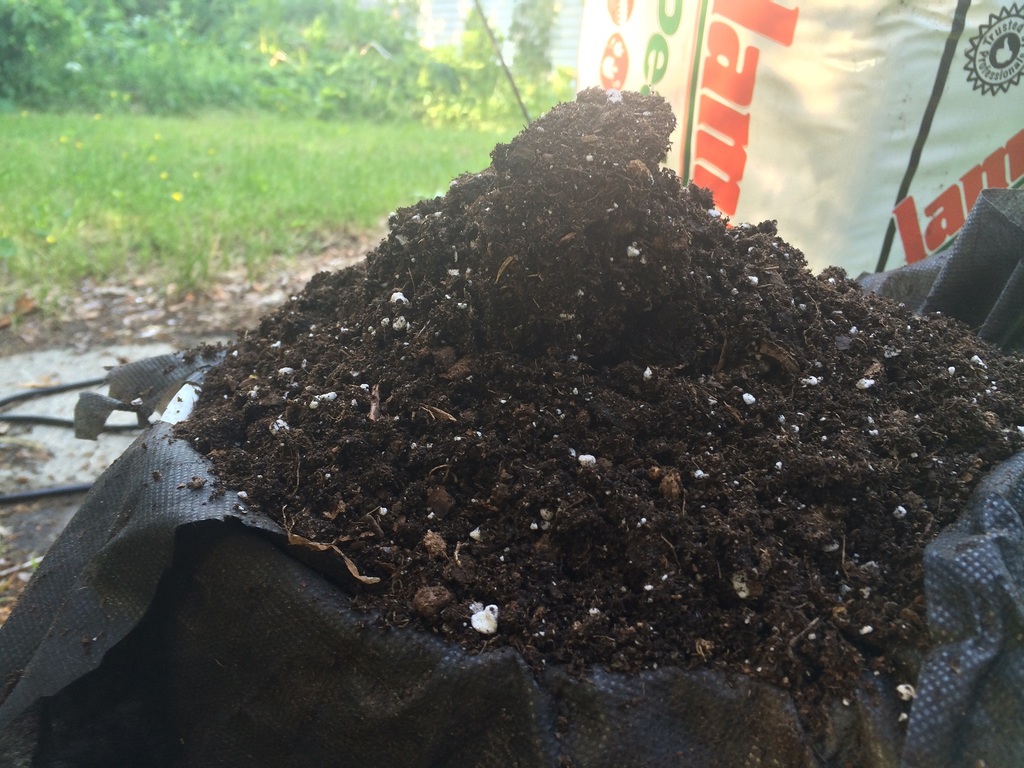
Oh, by the way, I have had success for years with this method......
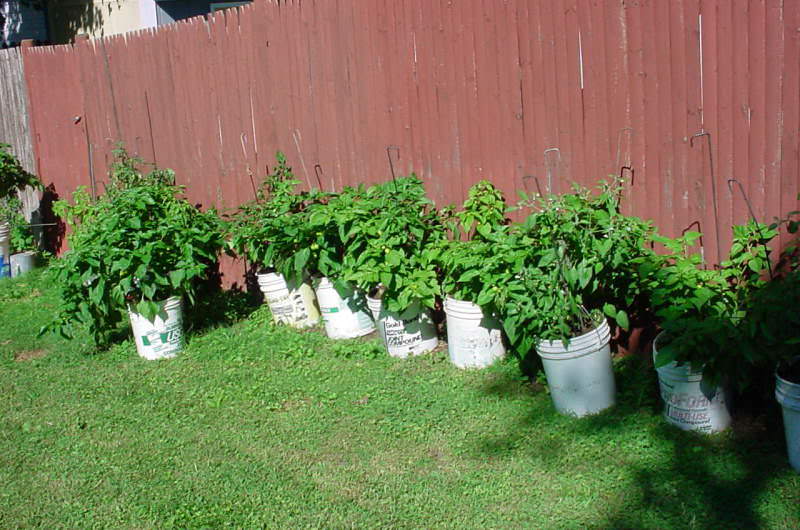
As always, YMMV.....NECM
The_NorthEast_ChileMan said:I use yard fabric to prevent my media (A mix of Miracle-gro potting media, peat moss, compost and perlite), from compacting over the small layer of pea stones at the bottom of my 5 gallon pails for a different reason - watering.
I suspect another benefit is that you're creating a scenario for better air exchange at the base of the media with a larger surface area exposed to atmosphere than if the majority of the media were pressed directly against the plastic bottom of the container. More moisture evaporates out, more oxygen is allowed in.
Thinking of the sponge analogy, a sponge will dissipate its moisture content more rapidly if the bottom surface is exposed to air (even through a porous surface) rather than being pressed up directly against a largely non-porous surface.
BTW NECM, like that pic of your plants along the fence. Hope that's this year's plants looking so good!
Oh, and to the OP, I would lean toward watering in greater volume every other day rather than a shallower watering every day, with the idea of encouraging deeper root growth and reducing evaporation.
The_NorthEast_ChileMan said:I use yard fabric to prevent my media (A mix of Miracle-gro potting media, peat moss, compost and perlite), from compacting over the small layer of pea stones at the bottom of my 5 gallon pails for a different reason - watering. (See below pix for this seperation method.) Let me explain this watering method.... Unlke a tropical environment with the threat of frequent downpours, in New England we can experience very dry periods that require frequent watering. I hand "weigh" my pails and wait until they are much lighter than saturated after my watering method. As I use liquid nutes mixed in the water I place pail in receptacle to catch inevitable run-off from the dry media and the open area around the stones allows the nute-water mix to be wicked up by contact rather than wasted as runoff.
That's totally legit. I converted to raised beds exclusively this year, but all of my buckets used to have perlite at the bottom. I would put the mix right on top, with a drain hole in the side of the bucket, about 2-3" off the bottom. The perlite would wick water up into the mix directly above, and no nute water goes to waste. That's kind of a perfect example of illustrating using the PWT to your advantage.
CaneDog said:
I suspect another benefit is that you're creating a scenario for better air exchange at the base of the media with a larger surface area exposed to atmosphere than if the majority of the media were pressed directly against the plastic bottom of the container. More moisture evaporates out, more oxygen is allowed in.
That's exactly what would happen, if not for the fact that eventually the media will fill the spaces between coarse aggregate, and then it's just back to higher PWT. Not the most efficient way to do that. You really want that exchange to occur IN the root zone, not below it.
If you want oxygen exchange, and better evaporation, you just use air pots or fabric pouches. Which also really only work well if you have relatively low humidity.
solid7 said:
That's exactly what would happen, if not for the fact that eventually the media will fill the spaces between coarse aggregate, and then it's just back to higher PWT. Not the most efficient way to do that. You really want that exchange to occur IN the root zone, not below it.
If you want oxygen exchange, and better evaporation, you just use air pots or fabric pouches. Which also really only work well if you have relatively low humidity.
Without fabric between the media and the gravel, that would occur. However, NECM is using fabric between the two to prevent that. Oxygen will reach the root zone from an exposed or significant porous surface, not through plastic. Given that the root zone will reach the bottom of the pot, it will become oxygenated in that area more quickly, and thus more optimally, with additional O2 penetration from the closer bottom rather than having to travel through the entirety of the mass from the top.
Air pouches are an option, if one has them. But air pouches also introduce new variables that may or may not be desired.
CaneDog said:
Without fabric between the media and the gravel, that would occur. However, NECM is using fabric between the two to prevent that.
which is exactly why I responded to his post, and said that this is how one takes advantage of the PWT to their advantage... that is a "wicking" bucket.
It is NOT the other case, however.
I should have also added that you get the most significant oxygen exchange at the top of the media. Like plants in nature... The better your media drains, the better oxygen exchange you have. Think of evaporation as an extension of this process. If you have evaporation or drainage, you're pulling oxygen into the media. In hydroponics, you get maximum aeration, when you agitate the surface of your nutrient reservoir, or blow air across it. (it's the greatest surface area)
That is why I suggested that you ideally want the oxygen rich zone above the bottom of the root zone, not below it. If you're wicking, you are drawing oxygen up through the media. If you top water, you're pulling oxygen in through gravity feed. Etc, etc, etc. If we trust that plants are performing transpiration correctly, it shouldn't matter if roots touch plastic, stone, clay, whatever. If you were to force feed oxygen in that's a whole different story, of course. I've seen some experiments with that, too.
That is why I suggested that you ideally want the oxygen rich zone above the bottom of the root zone, not below it. If you're wicking, you are drawing oxygen up through the media. If you top water, you're pulling oxygen in through gravity feed. Etc, etc, etc. If we trust that plants are performing transpiration correctly, it shouldn't matter if roots touch plastic, stone, clay, whatever. If you were to force feed oxygen in that's a whole different story, of course. I've seen some experiments with that, too.
https://flic.kr/s/aHsmFLZBxq
5 weeks between the pix / best thing that's happened this year. PWT must be a southern thing. I have never had it.
5 weeks between the pix / best thing that's happened this year. PWT must be a southern thing. I have never had it.
interesting debate. whatever works for you, meaning anyone here, is fine. i grow mostly in plastic buckets and have never put gravel or anything else in the bottom. all i put is the potting mix. when i start a new bucket i drill 30 or 40 holes in the bottom about 1/8 inch size. i used to worry if it drained fast enough sitting flat on the earth because i don`t have any holes on the sides to help with drainage. this spring we had rain nearly every day for a few weeks and they never were waterlogged to the point of hurting the plants. on occasion i will see a worm in one of my buckets and they had to get in through the drainage hole. also later in the season when i go to move a plant i find that roots have made their way out the drain holes and have rooted in the soil underneath. YMMV 

luvmesump3pp3rz said:interesting debate. whatever works for you, meaning anyone here, is fine. i grow mostly in plastic buckets and have never put gravel or anything else in the bottom. all i put is the potting mix. when i start a new bucket i drill 30 or 40 holes in the bottom about 1/8 inch size. i used to worry if it drained fast enough sitting flat on the earth because i don`t have any holes on the sides to help with drainage. this spring we had rain nearly every day for a few weeks and they never were waterlogged to the point of hurting the plants. on occasion i will see a worm in one of my buckets and they had to get in through the drainage hole. also later in the season when i go to move a plant i find that roots have made their way out the drain holes and have rooted in the soil underneath. YMMV
I actually think that's the best approach of the lot, if one doesn't mind letting them anchor.
CaneDog said:BTW NECM, like that pic of your plants along the fence. Hope that's this year's plants looking so good!
Actually that's from 2004.... My 2015 pepper family pic is @ Five Year Old Potting Soil Rejuvenation (Left click on the pic and it gets a bit bigger. And below are six plants from 2018.
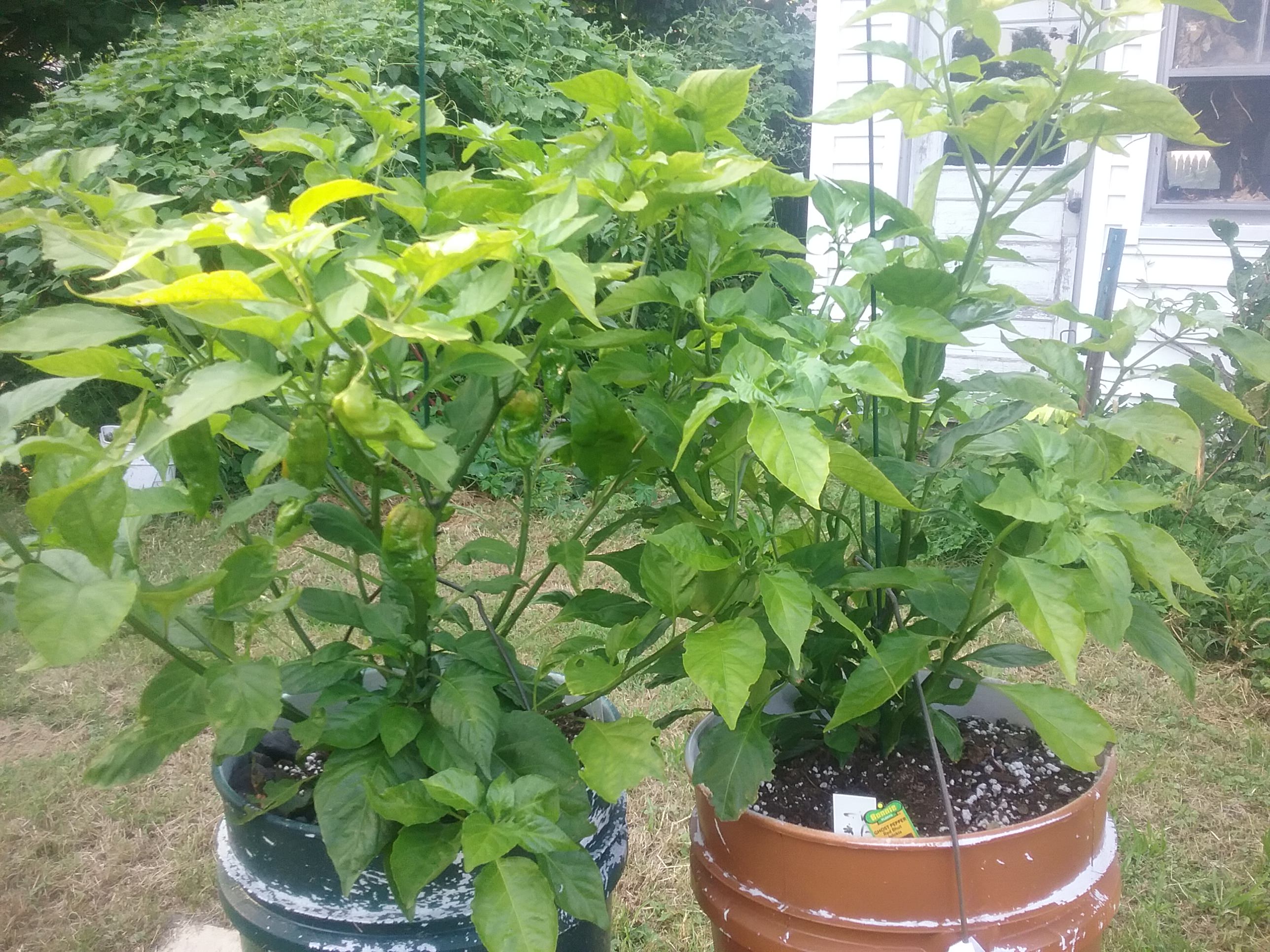
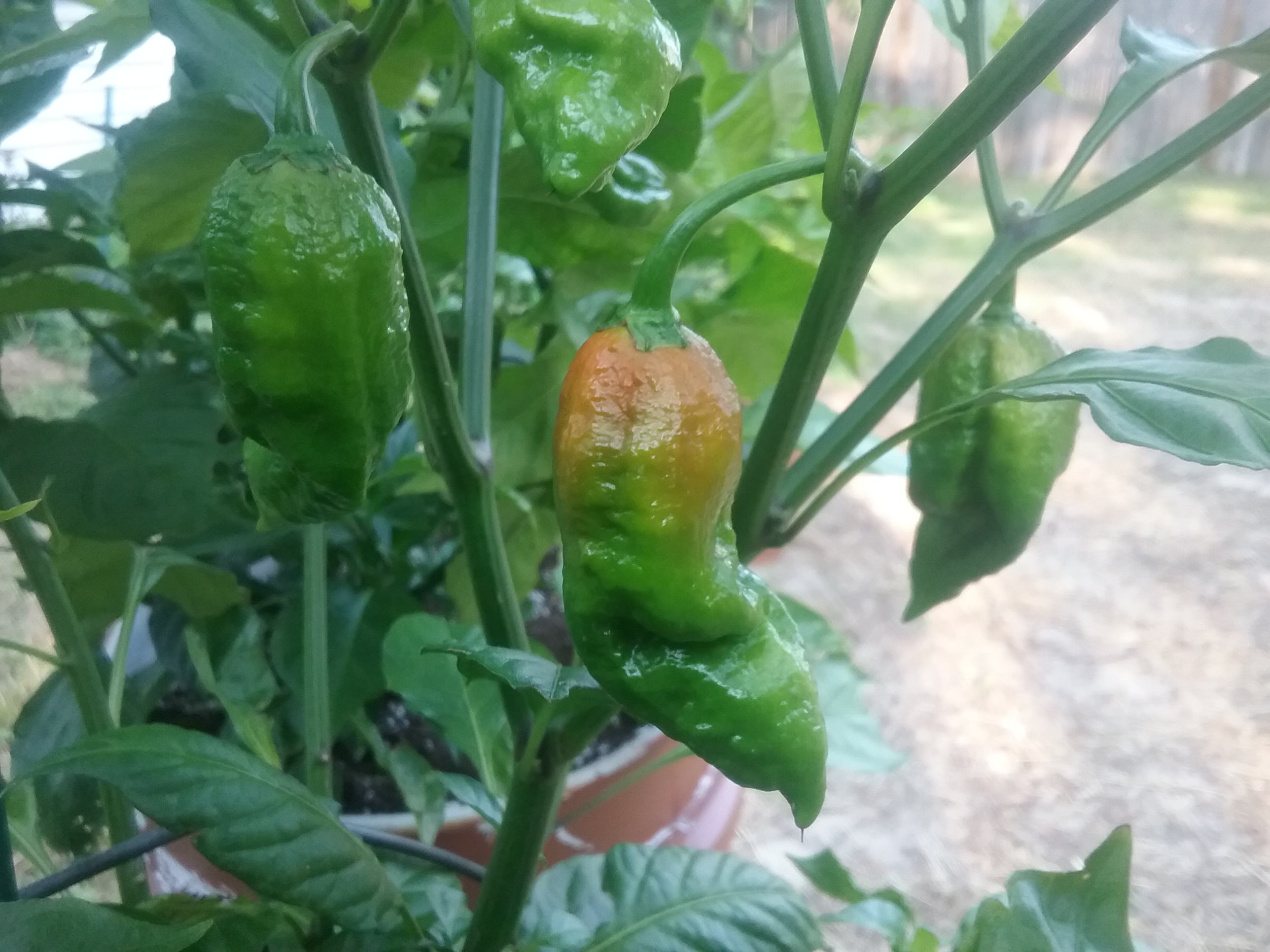
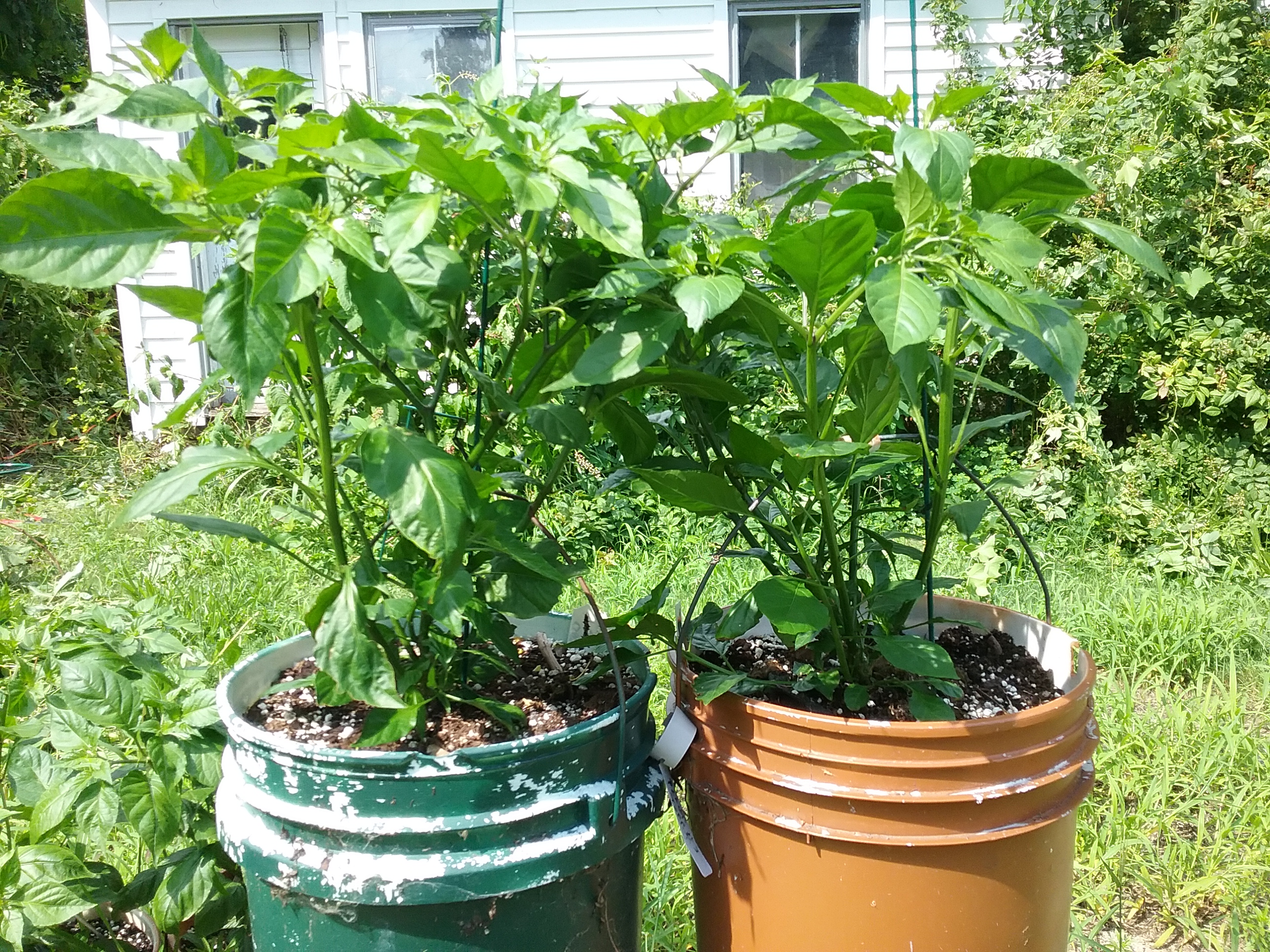
luvmesump3pp3rz said:interesting debate. whatever works for you, meaning anyone here, is fine. i grow mostly in plastic buckets and have never put gravel or anything else in the bottom. all i put is the potting mix. when i start a new bucket i drill 30 or 40 holes in the bottom about 1/8 inch size. i used to worry if it drained fast enough sitting flat on the earth because i don`t have any holes on the sides to help with drainage. this spring we had rain nearly every day for a few weeks and they never were waterlogged to the point of hurting the plants. on occasion i will see a worm in one of my buckets and they had to get in through the drainage hole. also later in the season when i go to move a plant i find that roots have made their way out the drain holes and have rooted in the soil underneath. YMMV
Hey Peppers. Same thing I do with my plastic containers. I'll sometimes even throw in some around the side on the 5g HD style buckets. I think I move mine often enough checking for slugs that I rarely have issues with significant roots coming though, except with my fabric containers which can root down awful fast if given the chance!
JohnT said:
Yellow habs looking good John!
